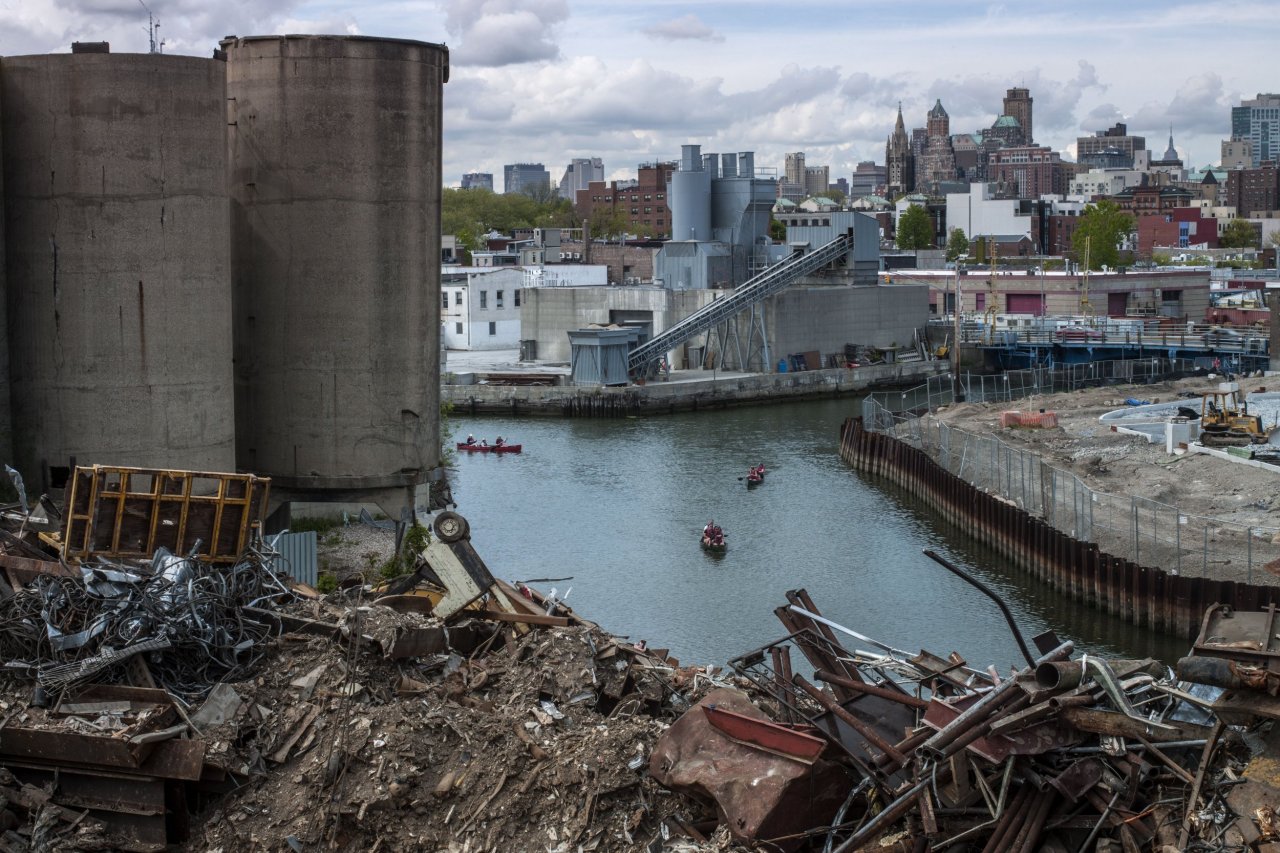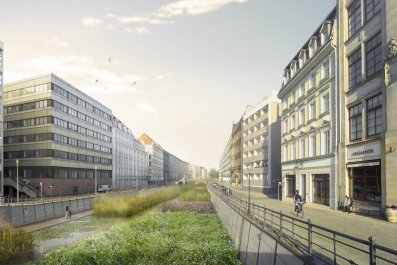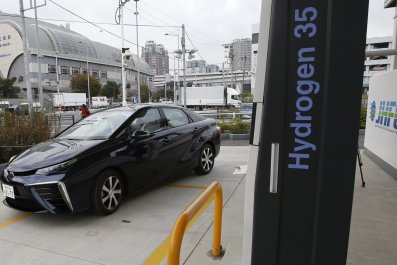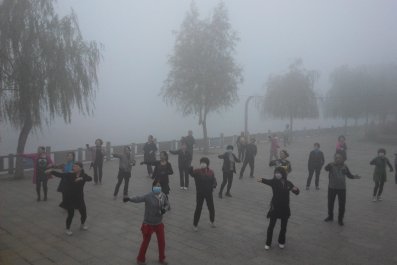Near the banks of the Gowanus Canal, an exceedingly polluted waterway that wends through brownstone Brooklyn for two miles, you can buy a deer fetus for $230 at the Morbid Anatomy Museum. The bruised little corpse was not fished from the canal, though the bodies of mafiosi used to routinely end up in these murky waters. So did those of dogs and cats.
Also on the canal, where Lenape natives once caught oysters bigger than Minnesota, is a Whole Foods, probably one of the very few in the nation to sit atop a Superfund site. A restaurant called Littleneck is well regarded for its bivalves; these did not come from the Gowanus, which is rife with toxic chemicals and human waste.
On one overgrown bank of the Gowanus, there are beehives, down the way from a canoe launch, which is hidden in the weeds, next to a parole office. There is a parking lot for double-decker tourist buses that take sightseers through Times Square. There is a contractor reputed to have connections to organized crime. There is an Italian restaurant, Monte's Venetian Room, which may be the oldest in Brooklyn. Frank Sinatra sang there, as did Sammy Davis Jr.
Somewhere near the Gowanus rest the bodies of several hundred soldiers from Maryland who fought off the British during George Washington's retreat in the Battle of Long Island. Historians think the Marylanders are buried beneath an empty lot, but the owners of the lot won't let them dig it up, so the mystery remains.
In 2007, a Minke whale swam into the mouth of the canal. Locals called it Sludgie. Sludgie languished for two days, then died, apparently from hitting its head on a dock. In 2013, a dolphin wandered into the canal. It also died. In 1950, a shark swam into the Gowanus. It was shot dead by police officers.
On hot days, Italian and Puerto Rican old-timers sit out in folding chairs before their row houses, watching young newcomers head to bars such as Swan Dive and Lavender Lake, which is an old name for the Gowanus Canal. The pensioners say nothing. It is a silence that reeks of disapproval.
In April, an environmental activist named Christopher Swain swam the Gowanus to highlight the waterway's plight. Though he wore plenty of protective gear, his mouth was in direct contact with the canal. "It tasted like mud, poop, ground-up grass and gasoline," Swain said after emerging. "It's just like swimming through a dirty diaper."
The canal may well be a dirty diaper, but it's also a case study in urban reclamation, one that could have implications from North Hollywood to the South Bronx. As people return to American cities, communities are cleaning up rivers that, polluted by industry and then neglected during suburban flight, turned into filth-filled troughs. The impetus is economics as much as environmentalism, with water access having become an urban amenity as coveted as basement wine cellars and climbing walls. It's in our genes. The Neanderthal craved being near rivers as much as the graphic designer in Austin; he just paid a lot less for it.

On a murderously hot Friday afternoon in August, I took a tour of the Gowanus with Joseph Alexiou, author of the recently published Gowanus: Brooklyn's Curious Canal. As far as either one of us can tell, it is the first book-length treatment of the canal. A licensed New York City tour guide who grew up in Long Island, Alexiou is short and energetic and given to cursing with great frequency.
"This is a Mafia fucking street," he said, perhaps a little too loudly. "Not everything can be fucking luxury," he said, in reference to the residential buildings now slowly rising along the banks of the Gowanus. "That's not how the world works."
A little later, we stood on the Carroll Street Bridge, a flat span with wooden slats that is one of the last four bridges in the country to retract for passing ships. We looked down into the water, about which the phrase "It looks like shit" can be used in the literal sense. A single maple leaf flowed past, and Alexiou joked that it was the first sign of autumn. But then another shape emanated from underneath the bridge, a translucent thing resting languidly on the surface. A sea creature emerging from the depths? Alas, no. This is the Gowanus, not the Great Barrier Reef. "Look at that," Alexiou said with awe. "What the fuck is that? That is a king-sized condom."
Indeed it was. Someone somewhere in Brooklyn flushed it down the toilet, and the prophylactic entered the ancient sewers of Brooklyn, some of which date back to the Civil War. When it rains, the storm water enters those sewers, which cannot handle the increased volume, so some of the waste and the surface runoff is dumped into the Gowanus via 11 pipes that deposit 370 million gallons of "combined sewage overflow" into the canal per year.
The Gowanus is not only the most polluted waterway in America but perhaps the most intractable. Fix this, and you can fix anything. Many a city has been remade in the image of New Urbanism, Brooklyn among them. But not the Brooklyn directly abutting the Gowanus. With its filth, its neglect, its decay, the Gowanus is a reminder of what we have done to our cities, the indelible scars we have left on the landscape, scars that cold-brew coffee shops and co-working creativity hives cannot fix.
Restoring rivers has often seemed a way to save entire cities, such is the significance we place on water and its health. While the Seine has always been a destination for those visiting Paris, the river itself could, in years past, seem remote from the city—civic symbol more than civic participant. That has been changing with the nouvelles berges, a project to return the austere embankments to the people. There are now, the BBC reported, "restaurants and bars, concert spaces, running tracks, a massive blackboard for children to scrawl on, cabins for rental where you can eat with friends, or hold business meetings." There have even been promises of a swimmable Seine, though that may be an instance of Parisian pride outpacing the realities of public health.
Unwilling to be outdone by its continental rival, London is holding an international "Back to the River" competition that has solicited entries for a new vision of the Thames, a river settled by the Romans 2,000 years ago. Meanwhile, in Germany, some want to "renaturize" a dirty stretch of the River Spree flowing through central Berlin, turning part of it into a swimming pool.
San Antonio is the American city with the most famous waterway reclamation project, the River Walk, a ribbon of easy pleasures. In Denver, the High Line Canal has been converted into a recreation trail running for 66 miles through the city and beyond. The Army Corps of Engineers is investing $1.3 billion in a restoration of the Los Angeles River, while city masters have asked architect Frank Gehry to come up with a plan for the waterway. Even poor old Yonkers, just north of New York City, has "daylighted" parts of the Saw Mill River by removing the concrete beneath which the river had been entombed.
Gowanus presents an especially complex challenge. Just a half-mile from its banks, residential properties routinely sell for millions of dollars. If current efforts by the Environmental Protection Agency (EPA) and others come to fruition, and the floating poop logs make way for otters and marsh grasses, the Gowanus could become the next High Line, the abandoned elevated railroad turned into a park-in-the-sky that revitalized the West Side of Manhattan and became a showcase for green ingenuity that has been replicated the world over. Or the Gowanus could languish in a bureaucratic inertia fostered by developers, community activists, environmentalists and politicians, all of whom want something but not quite the same thing. Already a horror story, the Gowanus serves as a cautionary tale for those who think that every city, from Akron, Ohio, to Juneau, Alaska, is ready to become the next Austin, Texas, or the next Portland, Oregon, or the next whatever.
The Gowanus was once a tidal stream whose banks were settled by the Lenape people. Dutch colonists built mills on the canal, becoming the first Europeans to see the commercial potential of the Gowanus. After a time under British rule, New York became a part of the United States, a nation that saw the commercial potential in everything. Accordingly, in the mid-19th century, the Gowanus's banks were fortified and its bed deepened, surrounding marshes drained. The Gowanus became one vast infernal machine with multifarious parts—burning, belching, spewing, stacking, grinding, loading and unloading, boiling and churning. The canal was an artery, but given 19th-century ideas about what to do with waste, it was also its own lower intestine.
Like the rest of the industry in New York City, the Gowanus entered a decline after World War II. Ships stopped coming, the Army Corps of Engineers stopped dredging, and the Gowanus became a toilet that nobody bothered to flush. Falling crime rates and rising quality of life in the 1990s benefited many previously maligned parts of New York. But they did not attract outlets of Armani and Dolce & Gabbana. Those ended up in SoHo, the warehouse district turned artists' enclave turned international shopping destination. Those who live on the Gowanus have watched all this with a mixture of envy and fear. They know that they may be next.
In August, the Gowanus Canal made history, appearing for the first time on the cover of The New Yorker, in an illustration by Adrian Tomine. The drawing shows a fashionable young couple enjoying a glass of wine on the banks of the canal. A dog sits next to the woman, while a child roots around in the undergrowth. Beyond the lavender waters of the canal, there opens an industrial scene: storage tanks, a mound of scrap metal, portable toilets. Near the bottom left-hand corner, at the feet of the male figure clad in skinny jeans, there are several paper grocery bags with what is a fuzzed-up Whole Foods logo.
As The New Yorker noted when the store opened, Whole Foods has a "knack for identifying neighborhoods on the cusp of gentrification." The housing crisis of 2008 halted the gentrification of the Gowanus area; two years later, the Superfund designation further dampened the enthusiasm of developers, whose zeal for urban reclamation vanished with the profit motive. But there is very little space left in brownstone Brooklyn and none at all in Manhattan, and so the enthusiasm has returned. The biggest project to date is a 700-unit apartment building from the Lightstone Group; renderings show the kind of glassy edifices that have risen in every nouveau-hip neighborhood from the Dogpatch in San Francisco to the Design District in Miami.
Most everyone agrees that the Gowanus needs to be cleaned up. But the tricky thing is that the Gowanus is not some inert piece of land, like most Superfund sites, waiting patiently for "remediation." Every time it rains, the sewers of Brooklyn overflow, and fresh waste goes into the Gowanus. The EPA's plan for the Gowanus is ambitious and, like most ambitious plans, very expensive. At a cost of $506 million, the agency will excavate an estimated 588,000 cubic yards of contaminated sediment, then put a cap on the sediment that remains. The EPA is also requiring that the city build retention tanks to handle sewage overflows. That could, the agency estimates, reduce the amount of "sewer solids" heading into the Gowanus by as much as 74 percent.
Others are taking more modest approaches. DlandStudio, the Brooklyn-based architecture and design firm, is starting a demonstration site for the Gowanus Sponge Park on a dead-end street abutting the canal. The sponge part is literal, with native grasses intended to capture surface runoff, preventing it from flowing into the Gowanus or into sewers and, from there, into the canal. The water would be remediated in wetland basins before making its way into the canal. With the proper funds and political will, the Gowanus Sponge Park would be extended as a kind of protective green sleeve around the canal, opening the banks to public access while cleaning up the water.
Susannah Drake, who heads DlandStudio, grew up in Vermont, on a stretch of the Connecticut River near the Dartmouth campus (her father taught there) that feels untouched by the modern world. "That's what the Gowanus used to look like," she says. To think the Gowanus can be returned to an Emersonian ideal might seem a delusive proposition, but Drake is confident that even this most unnatural of places is ready for a greening. She also believes her sponge technology could be "hugely applicable" across the city and beyond.
For now, the Gowanus remains pretty dirty and kind of cool. Every place has a history, but the canal has something rarer: a mythology. To hang out near the Gowanus is to announce an affiliation with the unseemly past, as opposed to the comfortable house-spouse-and-kids future.
I ventured to the Gowanus on a late summer night. Couples lingered on the Union Street bridge, while a crowd gathered in front of Ample Hills, a popular ice cream parlor known for the freshness of its ingredients. I went into Swan Dive, the new beer garden right on the canal's edge. For the most part, the place is shielded from the Gowanus, so you do not have to think about the canal if you do not want to. Most people did not appear to want to think about the canal. A movie played on a large projector screen. A family with young kids messily, happily devoured a plate of ribs. A well-to-do older couple played cornhole. Young women in summer dresses drank expensive beers.
I lingered at the edge of the space, leaning over the railing and looking down at the water below, ominous and obsidian. The secrets that water held! The toxic sediment harbored centuries of yearning: the yearning of Indian oystercatchers, Dutch colonists, American revolutionaries, men who toiled on its banks and men who perished in its depths. For centuries, we have been drawn to that water. And though the water is unclean, we are drawn to it still.




















